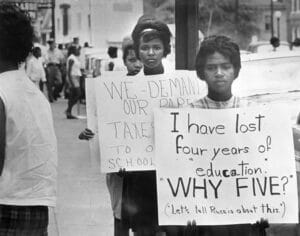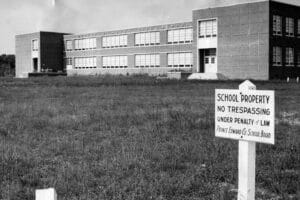Prince Edward County Schools Closed: the Civil Rights Movement
The history of the American Civil Rights movement and education includes the time period when Prince Edward County schools closed. Prince Edward County, Virginia, was the site of a student-led protest in 1951 against inadequate facilities at Moton High School. After the landmark Brown vs. Board of Education of Topeka decision in 1954, Virginia’s leaders called for action. Their policy to resist desegregation, known as “Massive Resistance,” became official in 1956.
Protesting Integration
In 1959 when Prince Edward County was ordered by a federal judge to integrate its schools, the county opted to shut down the schools rather than comply. The Prince Edward County school board used state tuition grants to open private schools for white children. It left Black children without any schools at all rather than desegregate the public school system.
The Missing Years of Education for Black Children
 For more than five years, black children were left without a school to call their own. Prince Edward County’s actions gained notoriety when Edward R. Murrow, a journalist with CBS, covered the story in a program entitled “The Lost Cause of 1959.” Several local churches and the Society of Friends (Quakers) stepped in to help and established private schools for black children. In 1963-1964, the Prince Edward Free School opened to help black children continue their education. Finally, in 1964, the U.S. Supreme Court ordered Prince Edward Schools to reopen. Even though the schools became officially desegregated, desegregation itself proceeded slowly until 1968 when the U.S. Supreme Court ruled in Green et al. v. County School Board of New Kent County, Virginia, that the “freedom of choice” plan was invalid did large-scale desegregation take place.
For more than five years, black children were left without a school to call their own. Prince Edward County’s actions gained notoriety when Edward R. Murrow, a journalist with CBS, covered the story in a program entitled “The Lost Cause of 1959.” Several local churches and the Society of Friends (Quakers) stepped in to help and established private schools for black children. In 1963-1964, the Prince Edward Free School opened to help black children continue their education. Finally, in 1964, the U.S. Supreme Court ordered Prince Edward Schools to reopen. Even though the schools became officially desegregated, desegregation itself proceeded slowly until 1968 when the U.S. Supreme Court ruled in Green et al. v. County School Board of New Kent County, Virginia, that the “freedom of choice” plan was invalid did large-scale desegregation take place.
A Bitter, Lasting Legacy
 The decision to fight desegregation in Virginia left a bitter, lasting legacy. Because the state had fought against desegregation, urban schools remained largely segregated until almost the 1970s. In 1971 Virginia passed one of the strongest provisions for public education out of all the states. Today, the all-black school where Barbara Johns led the student protest has become the Robert Russa Moton Museum celebrating civil rights and education. And although the schools throughout Virginia are integrated, many black members of the community still regret their ‘missing years’ of education due to the closing of Prince Edward County schools, a result of the shortsighted push to resist segregation by Virginia’s leaders in the 1950s.
The decision to fight desegregation in Virginia left a bitter, lasting legacy. Because the state had fought against desegregation, urban schools remained largely segregated until almost the 1970s. In 1971 Virginia passed one of the strongest provisions for public education out of all the states. Today, the all-black school where Barbara Johns led the student protest has become the Robert Russa Moton Museum celebrating civil rights and education. And although the schools throughout Virginia are integrated, many black members of the community still regret their ‘missing years’ of education due to the closing of Prince Edward County schools, a result of the shortsighted push to resist segregation by Virginia’s leaders in the 1950s.